
How much do you know about the appliances in your home? We often take them for granted, but most home appliances have fascinating stories. Here are some home appliance facts, history, and trivia that may give you a new appreciation for the appliances you use every day. We’ll also share creative uses for common appliances so you can look at your appliance with fresh eyes.
Kitchen Sink
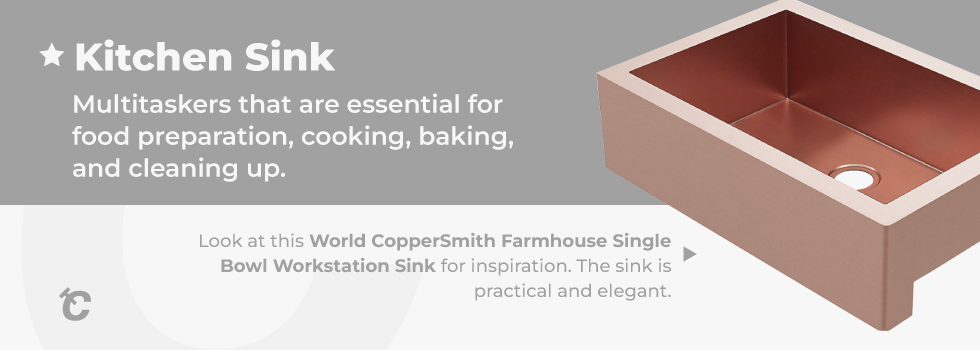
The kitchen sink is arguably the most used appliance in the entire kitchen. Because of this, a kitchen sink must be functional yet fit the personality and style of the kitchen. Kitchen sinks are multitaskers that are essential for food preparation, cooking, baking, and cleaning up.
The sink can also be the focal point of a kitchen, with a design that enhances the style of the kitchen. Sinks are crafted from copper, brass, stainless steel, porcelain, and other materials.Select a sink with the accessories you need to save time and enhance your kitchen experience. Look at this World CopperSmith Farmhouse Single Bowl Workstation Sink for inspiration. The sink is practical and elegant.
If you like room to multitask, this kitchen sink has the space and accessories necessary. The workstation sink can be customized with the finish and texture of your choice, whether you prefer smooth or hand-hammered copper or brass.
The single bowl is large enough to hold dishes, pots and pans, or baking sheets. This particular sink features a removable drying rack. The drying rack can also be used as a cutting board.
Refrigerator
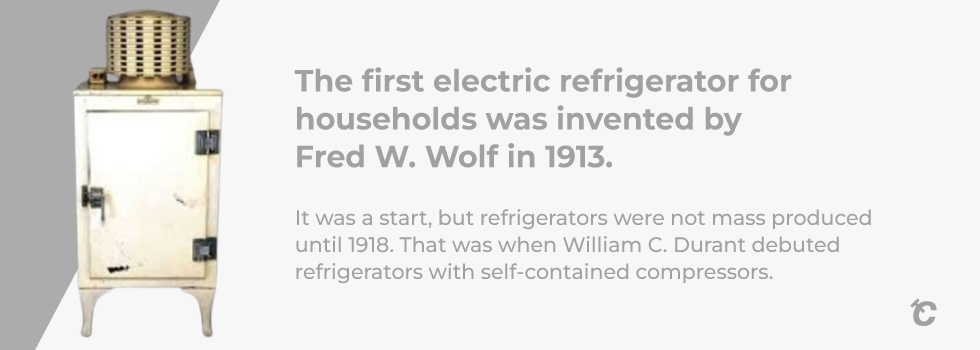
Before the advent of electricity, ice houses or cold cellars were used to keep food cold. In the 1800s, iceboxes gained popularity. These were somewhat similar to today’s refrigerators, minus the electricity. Iceboxes were commercially sold. Made out of wood or metal, the icebox was designed to hold a very large block of ice. The block of ice would be delivered on a regular schedule.
The first electric refrigerator for households was invented by Fred W. Wolf in 1913. This refrigerator functioned by having a refrigeration unit on top of an icebox. It was a start, but refrigerators were not mass produced until 1918. That was when William C. Durant debuted refrigerators with self-contained compressors.
Over time, refrigerators were updated and new features added. In 1923, Frigidaire introduced the stand-alone refrigerator. By the 1940s, freezer storage was added to have enough space for the popularity of frozen foods.
The first bottom freezer appeared in the 1940s. A side-by-side refrigerator made its first appearance in 1949. Consumers began viewing refrigerators as part of the style and decor of the kitchen around this time. In the 1950s, new color options such as pink, turquoise, blue, and pastel yellow became popular. Stainless steel refrigerators gained prominence in the 1990s. The design and functional innovations of this key kitchen appliance continue to the present.
The refrigerator revolutionized the home kitchen. Food could be safely stored for longer periods, cutting down on the need to shop daily. Refrigeration below 40° F slows bacterial growth and lowers the chance of food poisoning. The accessibility of the refrigerator and freezer encouraged more creativity in recipes and ingredients. Today, almost every home in the US has a refrigerator.
Freezer
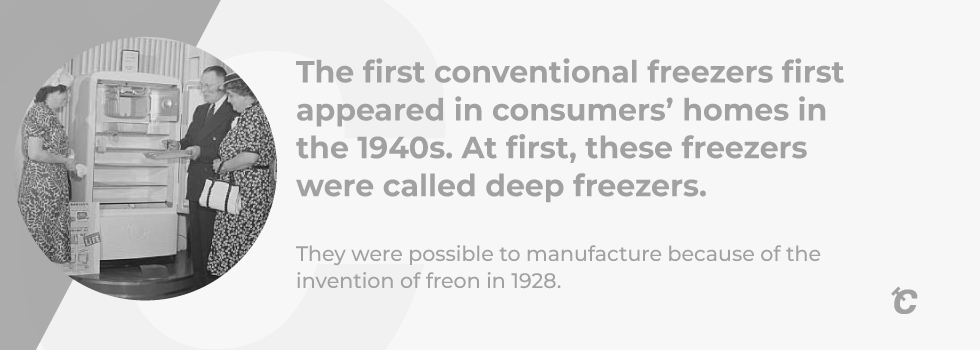
Did you ever wonder what life was like before freezers? Originally, there were ice pits. Deep holes or pits were lined with straw in the cold winter months. This only worked in areas with freezing cold winter temperatures.
The first conventional freezers first appeared in consumers’ homes in the 1940s. At first, these freezers were called deep freezers. They were possible to manufacture because of the invention of freon in 1928. Freon was considered a miracle invention because it was non-toxic, colorless, odorless, and non-flammable.
It wasn’t until after the Second World War that freezers were mass produced.
Electric Range
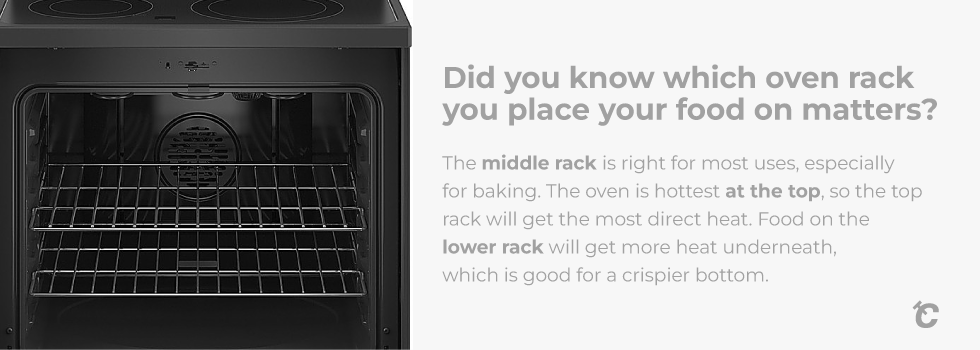
How did this popular kitchen appliance get the name “range?” An electric range is a stovetop and an oven combined into one convenient unit. Having burners and an oven offered a range of options for cooking, hence the name.
Count Rumford invented the first range in the 1790s. (He also invented a fireplace and the Thermos container.) Rumford’s range was fueled by fire.
Today’s ranges have amazing features such as self-cleaning ovens, an air-fry option, oven dividers, and griddles. The oven also functions as a slow cooker. You can slowly roast tomatoes for an authentic Italian pasta sauce, caramelize onions, or prepare vegetables for a variety of soups.
Clean a dirty cast iron skillet in the oven by placing it on a rack lined with aluminum foil. Turn the oven temperature to 450° for about an hour.
Did you know which oven rack you place your food on matters? The middle rack is right for most uses, especially for baking. The oven is hottest at the top, so the top rack will get the most direct heat. Food on the lower rack will get more heat underneath, which is good for a crispier bottom.
Where is the hottest spot in your oven? Do you suspect there is one spot that cooks food faster than the rest of the oven? You can do the toast test to pinpoint the exact location. Cover your oven rack with slices of bread. Now, toast the bread at 350°. Watch for the bread that toasts faster than the rest. You can avoid placing food in that spot if you don’t want it to overcook, or place food in that spot to speed up cooking time.
Range Hood

Kitchen range hoods come in many styles and finishes so you can coordinate the range hood to the overall decor of your kitchen. The range hood has the important role of removing excess moisture, heat, steam, smoke, and odors from the kitchen.
The kitchen range hood can be mounted on the wall over the stovetop. Some range hoods are installed under the cabinets or built into the cabinets. Over time, the range hood fan protects the cabinets from condensation and even grease buildup.
Some range hoods must have an outside vent. This may not work with certain apartments or small living areas, so keep this in mind. The alternative is a ductless range hood. This type of range hood doesn’t require an outside vent. Range hoods can be noisy, depending on the fan. The more powerful the fan, the louder it tends to be. Range hoods come in a large variety of customizable copper hoods, brass, stainless steel, and black range hoods. You can also select hood inserts that allow proper kitchen ventilation for a healthy environment.
This Euro ES1 Custom Range Hood looks like a piece of art and is available in a variety of finishes so you can create the perfect look for your kitchen. The Red Fire Copper finish is hand hammered by expert artisans to achieve a one-of-a-kind hood.
Microwave Oven
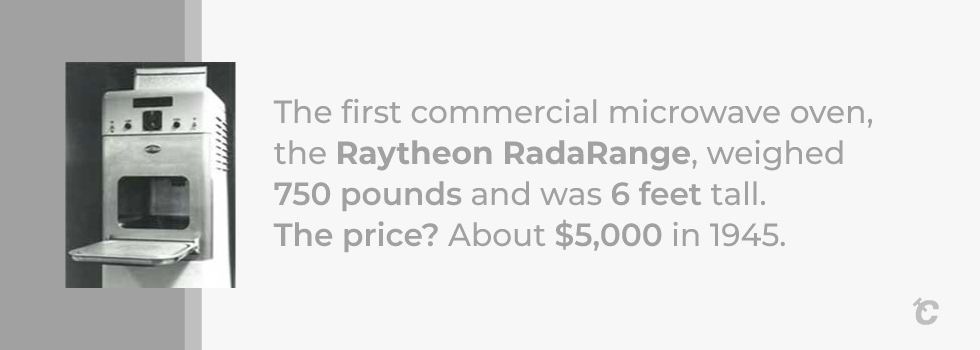
When Percy Spencer, an engineer for Raytheon, stood in front of a radar transmitter and the candy in his pocket melted, the first ideas about the potential of microwaves began dancing inside his head.
Originally, microwave ovens were large and heavy. The first commercial microwave oven, the Raytheon RadaRange, weighed 750 pounds and was 6 feet tall. The price? About $5,000 in 1945. The first prototype was used by a Boston restaurant.
The microwave does so much more than reheat frozen meals. Ever find your jar of honey has crystallized? Remove the lid and place the microwave-safe jar in the microwave. Microwave for 30 seconds and then stir. Repeat if necessary. The microwave oven remains a household staple because of its time-saving ability to cook or reheat meals, heat liquids, cook popcorn, and melt foods like chocolate and butter. Microwave ovens can be freestanding or over the range.
Dishwasher

The dishwasher is such a versatile appliance, it can even steam food. Place salmon in aluminum foil. Season with your choice of spices and add a splash of fresh lemon. Seal the foil and place the salmon in the top rack of your dishwasher. Don’t add dishwasher detergent! Run the dishwasher on a hot cycle and the salmon will be perfectly steamed by the time the wash cycle finishes.
Your dishwasher can also clean and sanitize sports equipment and athletic shoes. Simply load the gear in the top rack and run the dishwasher with the drying cycle off. Here are some interesting facts about the dishwasher. Most dishwashers last about 10 years and consume about 5 gallons of water per dishwashing cycle. The average dishwasher is run about 200 cycles per year.
Pre-rinsing your dishes before putting them in the dishwasher isn’t necessary. Today’s dishwasher detergents are designed to remove particles on dishes, so place your plates and other dishware in the dishwasher and let it do its thing!
Air Conditioner

If you live in a hot environment, it’s difficult to imagine life without an air conditioner. Did you know the first air conditioner was not invented to cool rooms?
In 1902, Willis Carrier invented the air conditioner. Strangely, the first air conditioning system was not used to cool rooms. The printing press at the Sackett and Wilhelms printing plant in Brooklyn, NY was having problems due to the high humidity levels in the building during the summer months.
Willis Carrier’s air conditioner was placed inside the printing plant. With the temperature and humidity levels now consistent, Sackett and Wilhelms’ printing press operated normally throughout the year. Even today, air conditioning does more than just cool the living environment. Air conditioners can filter out particles and allergens. Air conditioners remove hot air from your home, capture the moisture in the air, circulate cooler air, and filter out allergens so the air in the home is cleaner.
Washing Machine
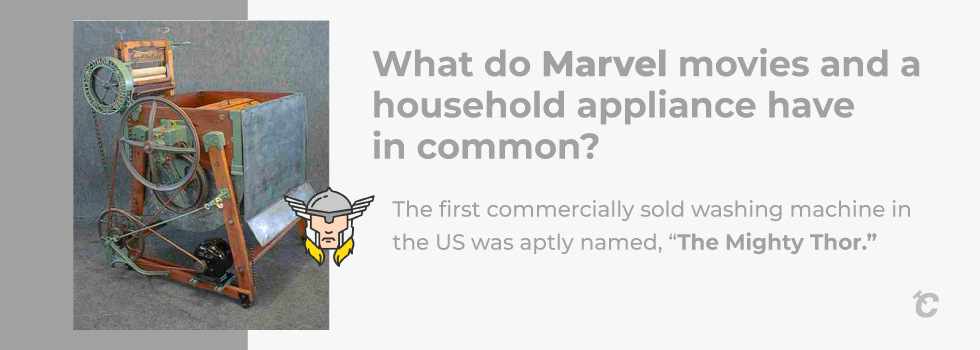
What do Marvel movies and a household appliance have in common? The first commercially sold washing machine in the US was aptly named, “The Mighty Thor.” Alva J. Fisher, an engineer for the Hurley Electric Laundry Equipment Company is credited with designing the washing machine. The drum style Mighty Thor debuted in 1908 with an electric motor and galvanized tub.
The washing machine had a huge impact on improving the roles of women in society. Traditionally, women spent hours and hours washing laundry by hand or with inefficient devices like wringers. The washing machine opened up hours of extra time.
Today’s washing machines are one of two types. There are front loader machines and top loaders. Front load washing machines use less water and take longer for the wash cycle. They do not agitate the clothes. Front load washing machines clean using a tumbling movement similar to clothes dryers. The spin cycles are usually very powerful.
Top loading washing machines have faster wash cycles. They tend to use more water and more electricity. These types of washing machines require less maintenance than front load washers. Cleaning takes place with agitation rather than tumbling.
Fun fact: the washing machine is a great multi-tasker. Not only does it keep our clothes clean, but the clothes washer can also be used to easily defrost food. Place the food in a sealed ziplock bag in the washing machine. Run the cold delicate cycle and remove the bag of food before the machine reaches the spin cycle.
Clothes Dryer (or Tumble Dryer)
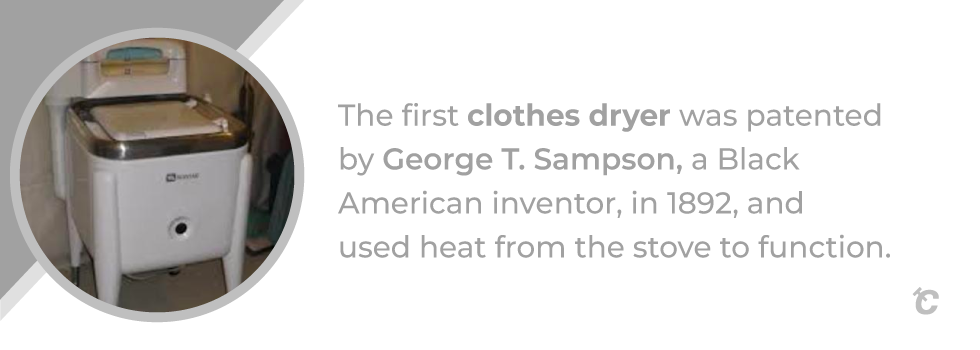
The first clothes dryer was patented by George T. Sampson in 1892 and used heat from the stove to function. Sampson was a Black American inventor who continued to refine his invention until he realized placing a rack over the stove prevented the clothes from catching on fire.
If you lived in frosty North Dakota in the early 20th century, you would understand how frustrating hanging wet clothes outside to dry in sub-zero winter temperatures could be. This dilemma motivated J. Ross Moore to come up with a solution. He began hanging his wet clothes in a little shed to dry. This helped, but installing a stove in the shed really improved the clothes drying process. Ross continued to modify and refine his clothes dryer concept for the next 30 years, experimenting with both electric and gas models, but he had difficulty finding a manufacturer for his concept.
Finally Moore came to an agreement with the Hamilton Manufacturing Company. The first automatic electric clothes dryer was launched in the US in 1938.
It may surprise you to learn that clothes dryers didn’t gain widespread popularity in the US until the 1960s. In places outside the US, including many parts of Europe, Asia, and Australia, hanging clothes on a line to dry is still the norm.
Home Appliances
Home appliances enable us to unleash our creativity in the kitchen, accomplish household tasks more efficiently, and make multitasking easy. Chances are you have every one of the appliances mentioned here in your home. These facts and tips will hopefully inspire you and help you get even more value out of your home appliances.
